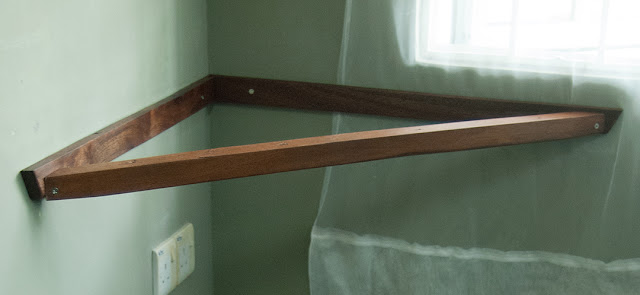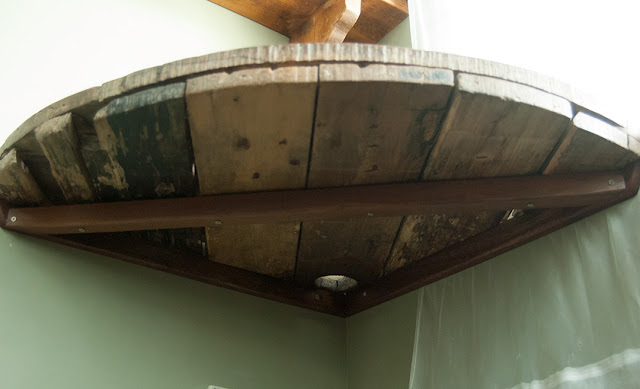Making a Quarter Corner Floating Standing Desk from Reclaimed Wooden Cable Reel
Hiya folks!,..
I had the fortune to find a pair of large wooden cable wheels on the side of the road a few months back and like any scavenger of gems in the rough, I was quick to reclaim them for their fated second life. Skip to a month back and me brainstorming ideas on how to free up more table and moving space in my studio and it became clear they (or at least one of them) would be the ideal solution!..
2 floating (wall mounted) tables were made altogether by dividing one of the cable reels. This 1/4 floating desk with a bottom shelf below, and another 1/2 standing floating table that was custom made to fit the the pillar in my studio.
As the custom size for the semicircular table required that it be slightly less than half of the cable reel, I decided to divide the remaining 1/2+ (for the corner quarter desk) into one bigger piece of equal lengths (top) and one lopsided smaller sized bottom shelf. This actually worked out to an ideal scenario as not only does this give space for my legs and feet to fit comfortably underneath the top desk but the lopsided size of the bottom shelf was just enough to fit both my harddrive and red cabinet underneath..
 |
| The full cable reel divided for all the tables. |
The Beginning
Ok, this wasn't quite the beginning, because when I first found these they were way, way more filthy (home of snails, mushrooms, moss and who knows what)
 |
| These were cleaned and disinfected as best as possible with boiling water and detergent and given a good scrub down. |
Yes, if you're wondering, I never managed to clean them entirely and my tables still have mud right deep in crevices that just could not be reached. I'm confident the boiling water did its job at disinfecting though and I'm fine with living with a little mud that can't be seen.. :)
Only the most rudimentary tools were used to make these tables throughout (except for my trusty power drill!) so it took some time (about a month) and quite a bit of bone aching elbow grease in the making.
Now let's get in to it, I'm not an expert by any measure, but this is what I did and hopefully it may give you some ideas for your own projects!..
Now let's get in to it, I'm not an expert by any measure, but this is what I did and hopefully it may give you some ideas for your own projects!..
Tools
- Hand Saw
- Miter Box
- 2 Clamps
- Chisel
- Jig Saw (not powered)
- Power Drill
- Hand Rasp
- Sandpaper (Grade: P80, 180 & 240)
Materials
- Reclaimed Wooden Cable Reel (this one was about 51 Inches in diameter)
- 1" x 2" Inch wood (I happened to have some store bought in the house)
- 1.5" x 1.5" reclaimed wood
- 4" x 1.5" reclaimed wood
- 2" Screws
- 2.5" Screws
- Plastic Anchors
Starting Off
 |
| Luckily I had this sort of bridge structure in my garden for a base to cut this huge (extremely heavy) cable wheel |
 |
| Making the first cut! |
 |
| As you can imagine, nails like this were a 'joy' to come across right where I needed to saw through.. |
 |
| Right after sawing. Planks fell off and some bits broke off in the process but these would all be screwed or stuck back later. |
It was now time to start sawing the wood for the supports.
 |
| Using the mitre box to cut the angles for the wood. This 1.5" x 1.5" piece would be used for the crossection of the top floating desk frame. |
 |
| All the pieces for the 1/4 floating table top. The surface of the cable reel was quite uneven and rough, so it has already been a bit sanded and carved smoother here. More sanding down to come. |
Refining and Carving out Rabbets & Pocket Cut for a Secure Fit.
Quarter Floating Table Top
 |
| Quarter Table Top: Once the pieces were cut to the lengths needed, the edges of the braces for the frame were carved and sanded for a nice rounded finish |
 |
| Quarter Table Top: To ensure a more secure fit for the quarter floating table top, a rabbet was cut all along its straight sides. This would fit over the braces that were mounted on the wall. |
Because of how thick the cable reel was (about 3 inches) it also exceeded any screws I had to secure it to the braces mounted to the wall. So carving the rabbets not only made the fit more secure, but now my screws were long enough for a good hold. :)
Besides that, the cross section would also be screwed into the table top from beneath for more support.
The angle of my wall was slightly less than 90 degrees, so rather than attach all the pieces together first and then mount them, I attached each piece individually to get a custom fit.
Once I was happy with the fit, 3 holes were drilled for the long 2.5" screws at the strongest points along the edge of the cable reel top (while it was fitted in place on the wall mounted braces).
Holes were then drilled underneath the table top to coincide with the holes already drilled in the wood of cross section of the mounted frame.
The table top was then screwed into the mounted frame securely (from above and below) and tested for strength.
 |
| Quarter Floating Table Top: Testing out the strength by leaving it for 24 hours with the heaviest items I could find in my studio.. |
Quarter Bottom Shelf.
 |
| Quarter Bottom Shelf: What will be supporting it. This weighty piece of lumber is super heavy and did not need to be fixed to the wall to give the support needed. |
 |
| Cut to fit. This piece of wood is so durable and has such a lovely weathered gray look I decided it did not need any further finishing. |
 |
| Picture X: The pocket cut underneath the cable reel would slot into this wall mounted piece of wood and then screwed into it from above to ensure a strong hold. |
The Final Wood Finish
Now that all parts had been cut, sanded, fitted and strength tested all that needed to be done were their final finishes. If you are interested in what I did for their wood finishes check out Candle Wax Wood Counter Finish (with Stain And Beeswax Finished Supports).
The Final Installation.
 |
| Supporting Frames |
 |
| The 1/4 Corner Standing table fully installed. Size Top: 70 x 70 cm, Bottom: 62 x 59cm (along the straight sides) |
Quarter Bottom Shelf
I started with the bottom shelf first. As mentioned, the supporting base for this did not have any finish applied to it as the raw natural look of the lumber was lovely and already durable enough to not need one.
The cable reel shelf itself which had been given a candle wax finish had had long black 2" screws, screwed at intervals along its straight edge to ensure the planks were strongly secured in place.
 |
| Only one original bolt that was luckily positioned in a place (not in the way of fixtures etc.) that enable me to preserve it. |
 |
| A long 2.5" screw, screws right through to the wood below that was mounted to the wall. This is the only screw that will hold the shelf down and in position. |
 |
| The 1/4 corner shelf fully installed. Size: 62 x 59cm (along the straight sides) |
Quarter Top Standing Corner Floating Table
Like the bottom shelf the cable reel desk top itself had been given a candle wax finish. The frame however had been given a nice dark stain and beeswax finish which contrasted nicely with the light cable reel top and shelf. Long black 2" screws had also been screwed at intervals along the straight edge of the cable reel top to ensure the planks were strongly secured in place.
 |
| The stained and waxed supporting frame mounted to the wall with anchors and 2" screws. |
 |
| Rabbet carved along the straight edges underneath the cable reel top that will fit over the mounted wall frame. |
 |
| The rabbet grooved top was slide into place over the mounted frame and then screwed into place with 2.5" screws. This was done in 3 of the strongest points of the tables edge. |
 |
| The cross section piece of the frame was then screwed into the top from underneath. |
 |
| Close up |
 |
| The hole at the back is a convenient way to keep all my wires tidy and out of the way. |
 |
| With everything strongly fitted this old cable reel is now ready for its new life ahead! |
And that's it!.. Hopefully you've found this post helpful. Please don't hesitate to ask away if you have any questions (please be reminded I am just a novice at this though).
Do check out DIY Reclaimed Wooden Cable Reel Semicircle Floating Table if you are interested in how the other half of this cable reel was transformed into a lovely pillar floating standing table too!.. :)
Thanks for the visit!.. :)
















Comments
Post a Comment